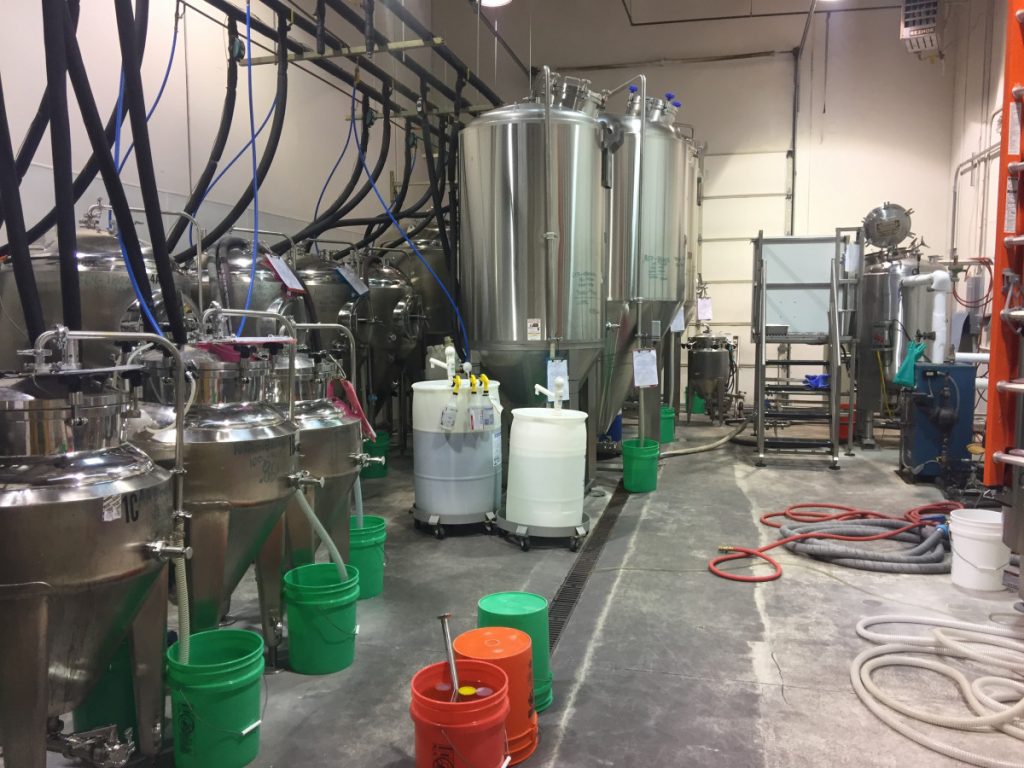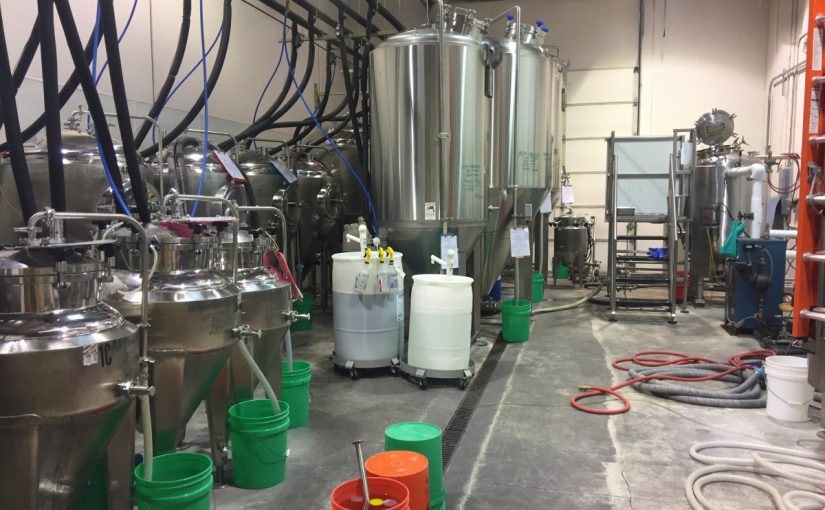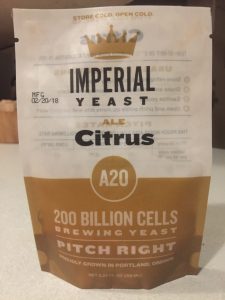Yeast is key to fermentation, and the reason why everyone doesn’t sit around drinking malted barley water or grape juice during times of leisure.
Yeast is a eukaryotic, single cell fungi. It is very much alive and reproduces asexually through the process of budding. A bulge is formed on the membrane of a cell, then the cell divides mitotically, detaching and creating an exact replica of the original cell. A yeast cell is around 5 to 10 microns thick, which is about 5 times the size of average bacteria.
Yeast was only realized to be the cause of fermentation in beer and wine in 1841. Before this time unwashed brewing paddles (and maybe a bit of magic) seemed to be the reason for the wort to ferment. Since that time thousands of yeast strains have been isolated for their specific qualities for fermentation.
The main genus of fungi used to ferment beer is saccharomyces. This yeast then has two leading species for brewing, each with hundreds of their own different strains.
One of the most readily used species of yeast is Saccharomyces Cerevisiae. This species is known as a top-fermenting yeast, or an “ale yeast”. This type of yeast will rise to the top of a fermentation vessel and create a thick layer of foamy krausen on the top. Saccharomyces Cerevisiae will ferment best at temperatures within the range of 60°-70° Fahrenheit, although some strains perform better outside these parameters. This species creates complex, rich flavors with fruity esters. It is definitely the most popular species of yeast in the craft brewing industry. In addition, S.Cerevisiae can ferment a broad range of sugars making it an extremely adaptable fungi. These sugars include: glucose, fructose, maltose, galactose, sucrose, mannose, maltotriose, and raffinose.
The other readily used species of Saccharomyces is S. Pastorianus which is a Bottom fermenting yeast, or a “lager yeast”. This type of yeast does not create as much foam as ale yeast, and will sink to the bottom of the fermentor quickly at the end of fermentation. Bottom fermenting yeast takes about double the time to complete fermentation as top fermenting yeast due to the cooler fermentation temperatures that it prefers (45°-60°F).The S. Pastorianus species was originally derived from S. Cerevisiae and hybridized with other varieties. Lager yeasts produce a crisp beer with simple flavors, which are also the most consumed beers in the world.
Another popular genus of yeast is Brettanomyces. Brettanomyces or “Brett” for short is technically a wild yeast, really just meaning that is has not been professionally cultivated for very long. There are five different species in the Brettanomyces genus, some of which are spore forming. Among the most popular of the genus is B. Bruxellenis which is also synonymous with B. Lambicus, and B. Intermedius. Recently Brett has become very popular for its funky phenols and fruity esters that it produces. It can cause barnyard, fecal, and metallic flavors, as well as highly fruity esters with a sour twist. Popular varieties that utilize this yeast are lambics, saisons, and American sours. Brewers are now using Brettanomyces in many different ways, supplementing their usual Saccharomyces pitches, and creating beers with original flavor profiles.
Different flavor profiles for beer developed regionally depending on localized yeast strains, and the various inputs that brewers made to maintain continuity. Now, with modern sanitation practices it is easy to purchase, and maintain a healthy collection of purebred yeast. There is significantly less worry than ever about contamination with wild, or non-specifically bred yeasts. Maintaining quality through multiple batches is now fully understood, and there is no room left for poor quality in the craft brew world.
The main flavor groupings associated with yeasts are esters and phenols. These are different varieties of chemical compounds that are present in the finished beer. Both are technically thought of as off-flavors, but are necessary in particular varieties, and interesting to experiment with.
Esters are usually fruity, and actually similar to the chemical compounds in the actual fruit that they taste like. Common flavors imparted by esters are banana, pear, apple, honey, rose, anise, pineapple strawberry, and sometimes solvent like flavors. Specific ester flavors are mostly dependent on yeast strain. Higher fermentation temperatures produce more esters than lower temperatures, which is why ales generally have more complex flavors. Wort composition will also effect how the yeast produces esters; sugars, zinc, and free amino acids increase overall ester production.
Phenols are definitely more unpleasant than esters; they produce burnt, smokey, peppery, tannin and even barnyard like flavors and aromas. Water with chlorine and bromine can cause unwanted phenols in beer. When brewing certain varieties, the addition of smoked malt will cause higher levels of palatable volatile phenols. Certain varieties of yeast such as Brettanomyces will bring out a phenolic profile. Farmhouse ales (saisons) thrive on the strange flavors of these usually unwanted phenols.
Saccharomyces does not technically require oxygen for fermentation, however, Brettanomyces does. It is common practice to aerate wort before pitching yeast, because without oxygen the yeast will starve and fermentation will slow or stop. Yeast requires oxygen for sterol synthesis which causes rapid growth and high cell density needed for fermenting beer (not respiration).
Other factors that affect yeast activity are the original gravity of the wort (amount of sugar in wort), temperature of fermentation (as stated above), contents and nutrients of grain bill, and proper sanitation procedures.
Once the proper amount of yeast is pitched (5-10 million cells per ml of wort), the fermentation begins. There are three phases to fermentation, the first is the lag phase, the second is the log phase, and the third is the stationary phase.
During the lag phase the yeast prepares to consume a large amount of sugar. As stated above, oxygen is needed for creating sterols and unsaturated fatty acids to promote exponential growth. The sterols and fats are also integral for strength and resiliency of the cell membranes. In addition, amino acids, peptides, and other proteins are taken in at this time.
The log phase is the stage of rampant fermentation. At this time sugars are being quickly consumed and cells are multiply at an expedited rate. The byproduct of yeast growth is the production of carbon dioxide and alcohol. This is also the phase where esters, phenols and other flavors are created due to accelerated cell multiplication. This phase is when the primary fermentation occurs.
Apparent Attenuation is the measured percentage of sugars converted to alcohol and carbon dioxide. Attenuation rates have a wide range depending on the yeast. A higher attenuation yeast will create a drier beer, while a lower attenuating yeast will create a sweeter beer. Attenuation can manipulated by mash temperature, necessary wort aeration, and fermentation temperature.
When the yeast reaches its stationary phase it has achieved maximum growth. At this time the yeast flocculates; it clumps together and drops out of solution to the bottom of the fermentor. Different yeasts will flocculate at different rates, while some do not at all. (During my research I found that Georgetown brewing, one of my favorite breweries in Washington uses a non-flocculating english ale yeast for all of their ales. Instead of the yeast naturally dropping, they use a centrifugal filtration system to clear the beer of yeast haze. This practice is being readily used recently to quickly produce craft beer.) The residual yeast in suspension works to convert remaining sugars of higher complexity, and process out unwanted compounds like diacetyl. High levels of diacetyl cause unwelcome buttery flavors and a slick mouthfeel.
The last batch of beer that I brewed used a yeast called “The Barbarian” by Imperial Yeast. Imperial Yeast is certified USDA organic, and cultivates a broad variety of yeasts, and some bacterias for both home-brewers and commercial brewers alike. Their yeast is packaged in a malt extract solution contained in a easy tear plastic pouch. Each pouch has 200 billion cells of yeast to ensure a perfect pitch rate for most small batches. Before brewing I was reading the yeast package, and noticed that the company was located in Portland, Oregon. I decided to contact them in hopes of a tour, and explanation of the commercial organic yeast cultivation process. Minutes after my first e-mail was sent I received a happily obliging reply from Casey, their customer service representative. After a few e-mails back and forth, I finalized a time for a private tour of the facility.

I arrived at Imperial Yeast and was met by an employee named Matt. He was the only one working that day, a Sunday, and was more than happy to give me a tour. We started the tour in the lab, where the yeast cells are manually counted under a microscope and algorithms are performed that ensure proper cell count in the packaged product. They recently acquired an analyzer that notifies them of the presence of wild or unwanted yeast strains that could have accidentally made their way in to a well-bred yeast; Matt was extremely excited about it!

We then both put on hair nets, beard nets, and safety glassed before proceeding into the main production room. In this room yeast was being grown in a multitude of vessels ranging in size from three to twenty barrel stainless steel containers. There was a large pressure cooker (about 10bbls) in this room used for sterilization. The room was sterile, organized, and immaculate. Each container had its own power, water, and large airlock. The temperature of this room was kept to exactly 72°f for aggressive yeast growth. We then moved into the next room which was warehouse and packaging space. Matt explained that they used to package their yeast in cans, but it complicated shipping, used too much equipment and took up too much storage space. He then showed me the difference in space of storage between the cans, and the newer pouches; it was a immense contrast. I got to see the packaging and sealing machine, the various cold storage spaces, and a new centrifuge for filtering out liquid (still in the testing stages).
At that point we stepped outside, viewed a new, massive pressure cooker, and went into another entrance of the building. In this section of the building was was more warehouse space, and a large walk-in freezer where consumer yeast was held. This freezer is also where their lactobacillus is grown for their sour blend yeast mix. Matt then offered me a pouch of yeast of my choice! I selected an ale yeast called “Citrus,” I was told that it would create the lime and tropical esters that I sought out for my next brew. I wasn’t able to get this variety at the local home-brewing store as they quickly sell out. Matt had just brewed a SMaSH (single malt and single hop) beer with that particular strain, so naturally we had to sample some of it and make sure that I made the right decision. It was a nice, simple beer with low malt flavor, and mild hop flavor, it definitely tasted young, and probably still needed time to mellow. Imperial Yeast can’t keep up with demands at the moment; renovations and expansions are currently in the works to keep up with their nationally acclaimed product and growing popularity. I am so grateful for the opportunity to tour this facility and pick Matt’s brain about the intricacies of organic yeast cultivation, and brewing. This feels to me like the final piece in my understanding of true organic beer production.

